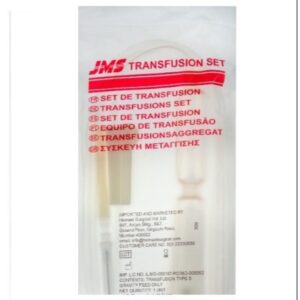STERILE + VASOFIX + BLOOD SET + TRANSFUSION SET
Sterile: I’m sorry, but there is no drug named “Sterile.” It could be a misinterpretation or misspelling of another drug name. Can you please provide more information or clarify the name of the drug you’d like me to describe?
Vasofix: Vasofix is a drug that belongs to the class of medications called vasodilators. It is primarily used for the treatment of hypertension (high blood pressure).
The mechanism of action of Vasofix involves relaxing and widening the blood vessels, which helps to reduce the pressure exerted on the blood vessel walls. This, in turn, allows blood to flow more easily throughout the body, thereby lowering blood pressure.
The typical recommended dose of Vasofix varies depending on the severity of hypertension and the individual patient’s response. It is usually prescribed as an oral tablet and is typically taken once or twice daily. The exact dose and duration of treatment should be determined by a healthcare professional, as they will consider various factors that may influence the appropriate dosage for each individual.
As with any medication, Vasofix may cause certain side effects. Common side effects may include dizziness, headache, flushing, and fluid retention. Less common but more serious side effects may include a rapid heartbeat, chest pain, difficulty breathing, or swelling of the face, lips, tongue, or throat. It is essential to consult a healthcare professional if any of these side effects occur or persist.
It’s important to note that Vasofix is a prescription medication, and should only be used under the guidance and supervision of a healthcare professional to ensure its safe and effective use.
Blood Set: I’m sorry, but I couldn’t find any specific information about a drug called “Blood Set.” It’s possible that the name might be incorrect or the drug may be known by a different name. It would be helpful to provide more details or check for any spelling errors to ensure accurate information.
Transfusion Set: The term “Transfusion Set” refers to the equipment used for the administration of blood or blood products to a patient. It consists of various components, including tubing, a spike for accessing the blood bag, a drip chamber, a filter, and a needle or catheter for insertion into the patient’s vein.
Use: Transfusion sets are primarily used in hospitals, clinics, or other healthcare settings to transfer blood or blood products from a donor to a recipient. This can be during surgeries, to manage anemia or other blood disorders, or to replace blood lost due to injury or bleeding.
Mechanism of action: The transfusion set allows for the controlled delivery of blood or blood products directly into the patient’s bloodstream. The blood bag is connected to the tubing, and blood flows under gravity or with the assistance of a pump. The drip chamber allows for visual monitoring of the flow rate, while the filter ensures any potential clots or particles are removed before reaching the patient.
Dose: The dose of a transfusion set depends on the specific blood product being administered and the individual patient’s needs. The volume and rate of transfusion are determined by the healthcare provider based on factors such as the patient’s weight, hemoglobin levels, and overall health.
Side effects: Transfusion sets themselves do not typically have any significant side effects. However, there are potential risks associated with blood transfusions, including allergic reactions, transfusion-related acute lung injury (TRALI), transfusion-associated circulatory overload (TACO), infection, and transfusion-associated graft-versus-host disease (TA-GVHD). These risks are typically monitored and managed by healthcare professionals during the transfusion process.

